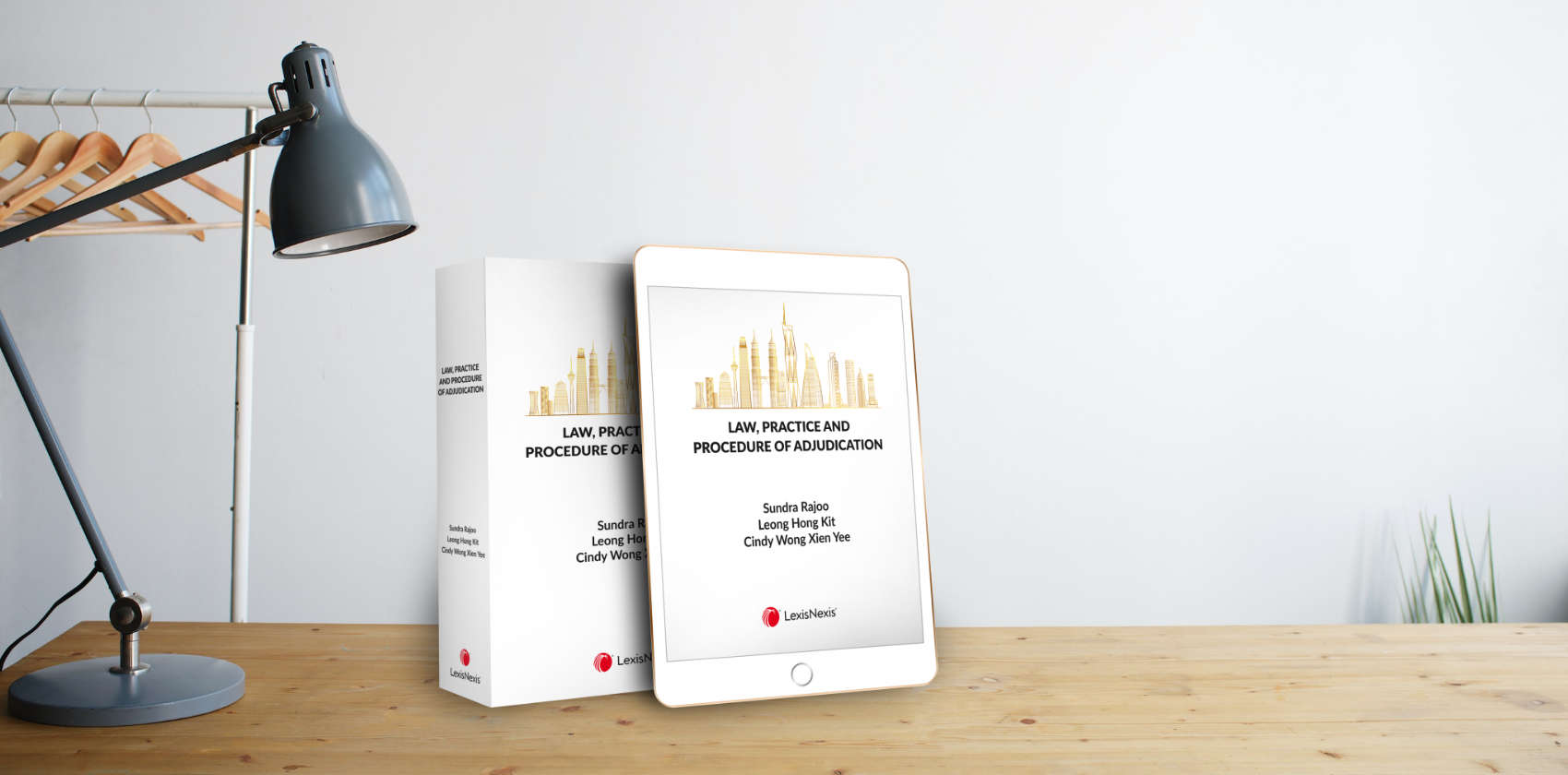Law, Practice and Procedure of Adjudication
By Datuk Prof. Sundra Rajoo, Leong Hong Kit and Cindy Wong Xien Yee
Since the birth and coming into force of the statutory adjudication scheme in Malaysia in 2014 under the Construction Industry Payment & Adjudication Act (CIPAA 2012), it was the Asian International Arbitration Centre (AIAC) (then known as the Kuala Lumpur Regional Centre for Arbitration (KLRCA) which implemented the scheme, under the directorship of Datuk Professor Sundra Rajoo (Sundra Rajoo). He thus has direct deep and personal practical knowledge of the subject.
The combined wealth of knowledge and experience of Sundra Rajoo, his co-authors Mr. Leong Hong Kit and Ms. Cindy Wong Xien Yee and editorial team of Ms. Ng Chu Yin and Ms. Kanmani Global is evident in the depth of the analysis and elucidation of live issues and the practical aspects of statutory adjudication in the 22 chapters of the book.
This massive 1774-page useful and timely book consists of eight divisions, covering a whole gamut of issues that tend to arise before, during and after adjudication proceedings. The book provides detailed analyses and practical guides for all parties involved in such proceedings, as well as sample forms and checklists.
As stated by Dato’ Lee Swee Seng, Judge of the Court of Appeal in her Foreward to the book, “keeping abreast with this area of the law is challenging and this book has sought to capture, compile and comment on the cases under useful headings that would help all, either venturing into this area of law as beginners or those already familiar with its terrain and topography.”
As stated by Sundra Rajoo in his Preface to the book, the intention of “Law, Practice, and Procedure of Adjudication” is to provide readers with an almost complete reference guide to answering important questions which arise during the course of practice of adjudication particularly in Malaysia and perhaps, elsewhere. I am pleased to observe, in going through the book, that this objective is met, particularly in describing fully the status of the subject (as at 7 December 2022).
Division 1 of the book is an introduction to the law, practice and general procedures of adjudication in Malaysia, as well as in the UK, Australia, New Zealand, Singapore and Canada. It provides a succinct history of statutory adjudication, beginning from “The Latham Report” in 1994 which recommended that “the adjudication system could become the key to settling disputes in the construction industry”, and which led to the “Housing Grants, Construction and Regeneration Act 1996” in the United Kingdom; leading to similar legislation in Australia, New Zealand and Singapore, and then CIPAA in 2012 as aforesaid.
Sections [1-35] to [1-38] briefly describes the history of implementation of CIPAA 2012, which started with claims by small contractors against recalcitrant domestic paymasters in its first few years, and then encouraged larger contractors in later years to bringing larger and more complex claims; and then more and more cases in courts which dealt with the enforcement of adjudication decisions and disputes relating to jurisdictional issues and alleged breaches of natural justice. A table at [1-38] shows zero applications in 2013, to one application in 2014 to steep increases of such cases, in fact up to 178 cases from January to September 2022.
Section 1.2 provides useful summaries of prominent cases, which have for instance established so far, that CIPAA 2012 is constitutional; and that it does provide for substantive rights.
Sections [1-66] to [1-79] provides a chronological part by part summary of the various parts of CIPAA 2012, with a useful Flow Chart at [1-179] for a birds-eye view of the whole process.
Division 2 describes the role of AIAC and its rules for operating the scheme. As described in Section 32 of CIPAA 2012, AIAC is its adjudication authority, responsible for administrative support and for adjudicators’ competency standards and criteria, as well as appointment terms and fees of adjudicators.
Section 2.5 helpfully set out summaries of some of the Circulars previously issued by AIAC, which courts have held are useful as guidelines (though there have been differences on their binding effect). The various circulars have dealt with matters such as the effect of circulars themselves, the fees and expenses of adjudicators, the application of sales and service tax, costs, calculation of “working days”, service of documents, delivery of adjudication decisions and various other practical matters.
Division 3 describes the procedures and provides a practical guide, with references to relevant court decisions in Malaysia and other countries.
Chapter 3 of Division 3 deals with matters concerning the “first document” and “trigger” i.e. the Payment Claim. It is a very helpful and substantial 230-page chapter which goes into the contractual and statutory pre-requisites for activating the adjudication process. It also delves into common issues such as whether terminated contracts are covered by CIPAA 2012 (according to Malaysian courts and those in other jurisdiction, they are); and whether “final claims” are (also according to Malaysian courts, they are). The chapter also deals with mechanisms and practical aspects of payment claims.
Likewise, the 80-page Chapter 4 of Division 3 sets out a roadmap for the non-paying party, the provisions for which are set out in Section 6 of CIPAA 2012. A considerable part of this chapter also deals with the prevalent issue of jurisdictional challenges; and sets out the practices and views of the courts on such challenges. Other topics include matters such as set-offs, abatement, cross-claims and corruption, res judicata and estoppel. Under CIPAA 2012, as confirmed by the courts, an adjudicator is not excluded from considering all defences raised by a respondent in an adjudication response whether found in the payment response or not; and a non-paying party who fails to respond to a payment claim is deemed to have disputed the entire payment claim. (These features are noticeably the opposite of the policy and provisions of the Security of Payments Act (SOPA) in Singapore.)
Chapter 6 deals with, amongst other things, matters concerning the consolidation of two or more adjudication proceedings into one single proceeding concerning all parties and all disputes to avoid repetition or duplication to save time and costs.
The other chapters of Division 3 deal with various policy, conceptual and practical matters during the adjudication process, such as Notices, Pre-action considerations, appointment of adjudicators, adjudication claims and responses.
Division 4 is a guide for adjudicators, on topics such as jurisdiction, powers, duties, obligations and decisions of adjudicators. Chapter 11 in this division deals with the all-important subject of the jurisdiction of the adjudicator, including the authority, mandate and competence of the adjudicator. The chapter delves, amongst other things, into the adjudicator’s “core jurisdiction” (i.e. whether or not the subject matter of the dispute is one which is conferred by CIPAA 2012); “competence jurisdiction” (i.e. the validity of the appointment of the adjudicator); and “contingent jurisdiction” (i.e. whether matters raised in the payment claim and payment response fall within the adjudicator’s jurisdiction).
Division 5 deals with miscellaneous issues including confidentiality, immunities of the adjudicator and the appointing body, and service of notices and documents.
The substantial 330-page Division 6 deals with post-adjudication issues, including enforcement of adjudication decisions, setting aside and stay applications.
Division 7 is a very useful resource which discusses the development of cases (up to 2022), divided into various cases coming under hundreds of diverse topics (ranging from conceptual ones such as “Pay Now, Argue Later”, consequences of failures to file payment responses, failure to issue certificates, stages at which jurisdictional objections could be brought, decisions on interest rates and costs, stay of adjudication decisions, fresh assertions and evidence after a decision, cases where the issues were breaches of natural justice, as well as many other miscellaneous issues).
Division 7 includes certain Conclusions and Recommendations by the authors. The recommendations (some of them following amendments made in the adjudication regime in Singapore) include: a suggestion that CIPAA 2012 be amended to follow the amendment to SOPA in 2018 by which jurisdictional challenges not be permitted in adjudication responses if they were not raised in payment responses save in certain limited exceptions; suggestions to control large and complex claims for uncertified/ disputes damages, loss and expense; imposition of time limits for setting aside applications; control of tiers of appeal; payment of adjudicated amounts to the AIAC before setting aside applications can be filed; and processes for replacement adjudicators. It seems likely that these, in my view sensible, recommendations will lead to some changes in CIPAA legislation in due course.
The Appendices to the book include resources such as CIPAA 2012 itself, AIAC’s Rules & Procedure, AIAC’s Circulars; as well as scenario-based samples of payment claims, payment responses, adjudication decisions. Appendix 3 is a useful Checklist, useful for all users of CIPAA 2012.
All in all, this 1774-page tome (packaged in two well-organized Volumes) is a useful one-stop shop resource for all practitioners and adjudicators in Malaysia involved or interested in any way in CIPAA 2012. It is also useful for practitioners and academics in other jurisdictions (such as Singapore and states in Australia) for comparative study of adjudication policies and practices; as well as countries still studying the viability of introducing adjudication (such as Hong Kong). I congratulate the authors for this commendable writing achievement. I am proud to have this useful book in my own personal library on adjudication and dispute resolution.






